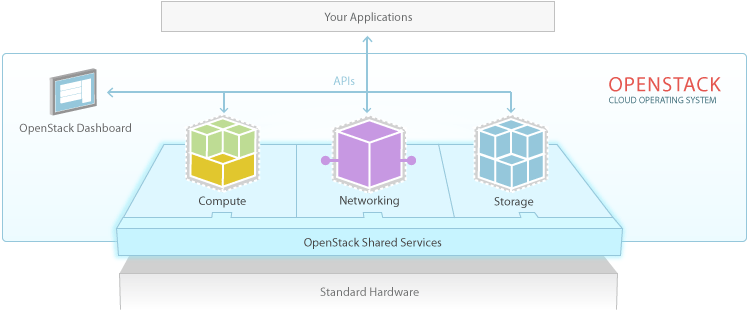
Now is becoming clear, but some years ago, people still was thinking that OpenStack was a kind of VMware open platform to create virtual machines. Never was the case, Openstack is just a framework to build Infrastructure as a Service (IaaS), and software like VMware VSphere/VCenter are just platforms to run VM’s which can be integrated within OpenStack. That is the reason why big vendors like VMware, Cisco, etc. see OpenStack as an opportunity for offering their products or services than a competitor. Those are the keys:
Infrastructure
It is about managing resources in a datacenter, they can be physical or logical. With a physical server (bare metal) I want a way to manage it (deploy, re-deploy, wiping, power on/off …), the same with a logical compute resource as a VM, a storage volume (LUN) is another kind resource to keep data … there are also load balances, networks, IPs … and more recently containers, those are resources too!. The aim of OpenStack is provide a homogeneous way to easily manage those heterogeneous resources by abstracting the implementation, specific vendors infrastructure. The idea is: you need a volume, but you do not mind if is provided by NetApp, by EMC … likely you can say that the data is going to be really critical, but small size, and you are expecting a lot of writes … if you want a VM, you do not care which kind of hypervisor is the best, maybe you want to be high available, so run it on VMware; otherwise maybe you prefer taking care about the availability implementation.
Framework
It is a modular framework, because people can define the architecture, which components, and integrations with other platforms. There are some base reference set-ups.
Openstack is not going to offer you more features than the backend devices do, in the same way than the Linux kernel does not offer more features than the hardware has. For example, if you are using a load balancer like F5, you will get high availability, but not because of OpenStack, only because of the backend device, if you want to provide block device volumes within OpenStack, you can setup a Ceph cluster, but is up to you how resilient is going to be .. Moreover, software libraries do not replace developers and OpenStack is not here to replace system administrators, they need to setup the backend services, maintain them, upgrade, …
API
Everything is based on HTTP RESTful API to control the resources, each one has an associated service allowing you manage it by simple HTTP requests. This schema changes completely the workflow, it allows fast delivering, a clear distribution of teams and responsibilities, accounting and report management of the resources.
This new workflow fits perfectly with agile teams and DevOps culture. Teams use the APIs, they are responsible of the implementation on top of the infrastructure. Its in-house cloud computing, an Amazon AWS cloud in the datacenter.
Open Source
Currently, OpenStack is one of the most big and active projects in the open source community, involving developers from different companies. They are working together to achieve a kind of de facto open standard for cloud platforms. The software is going to be the same independently the company who supports or sells it: no vendor lock-in. Of course, vendors can include other aditional extra services, drivers for hardware, dashboards, etc. in order to integrate it with their products. But, OpenStack services (and API) are going to be the same, there will be no “Enterprise Edition”, no “open core”. They are commited to it, from the wiki: “OpenStack is open source, openly designed, openly developed by an open community”. OpenStack ecosystem projects are released under Apache License 2.0.
Released in a cicle of six months, there is also a summit where they together decide next features: having meetings, making decisions … all the discussions and notes are open to the rest of the community. And … who is in charge of the long-term phylosophy and promises?, a non-profit foundation (openstack.org) formed by a board of directors, a technical committee and a user committee, which guaranties the mission of Openstack: “produce the ubiquitous Open Source Cloud Computing platform that will meet the needs of public and private clouds regardless of size, by being simple to implement and massively scalable”.